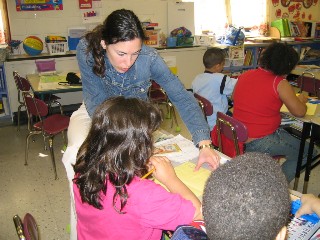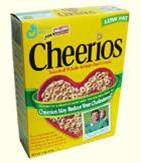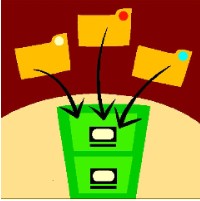April 2006

Featured Topic: Writing in Math Class
Teachers incorporate writing in math class to help students reflect on their learning, deepen their understanding of important concepts by explaining and providing examples of those concepts, and make important connections to real-life applications of the math they are learning. Teachers use the writing assignments to assess student understanding of important concepts, student proficiency in explaining and using those concepts and each student's attitude toward learning mathematics. Writing in mathematics is a win-win for both teacher and student. Although it may be difficult to introduce this practice, it is well worth the effort. Look for simple ways to incorporate short writings throughout daily lessons and longer writings over the course of weeks or math units.
See Writing in Mathematics for specific suggestions on developing writing skills in mathematics. This article also includes links to online sources for writing prompts and strategies that are effectively used to help students use writing to make sense of the mathematics they are learning.

Recent Additions to Mathwire.com
Check the New on Mathwire.com webpage to see what's new on the site.
Enter your email address below to receive notifications when new content is added to Mathwire.
Featured Technology Links: Probability Tools
Students learn early on that small samples are often skewed and that they need larger samples to more closely approximate the theoretical probability. Online probability tools enable students to quickly generate large trials and analyze the results.

-
 Dice Roll with graph: students press the space bar to roll two dice and record the result in a bar graph.
Dice Roll with graph: students press the space bar to roll two dice and record the result in a bar graph.
- Project Interactivate's
 Experimental Probability allows students to customize dice and spinners to run virtual trials.
Experimental Probability allows students to customize dice and spinners to run virtual trials.
- Ken White's
 Coin Flipping Page allows students to conduct virtual coin toss experiments.
Coin Flipping Page allows students to conduct virtual coin toss experiments.
-
 What Are Your Chances? asks students how many times they wish to roll two dice, then presents a bar graph of the results.
What Are Your Chances? asks students how many times they wish to roll two dice, then presents a bar graph of the results.
FEATURED TOOL: Online Cereal Toy Investigation Simulator

This applet, designed by Erin Mulder, allows students to conduct multiple simulations and collect data on a larger sample. Students may run 20-30 trials more quickly than the dice toss. The applet is probably best used following the class data collection simulation with 6-sided dice. In this simulation, students will need to collect data on the total number of boxes bought to get all 6 toys so they must decide how best to record that data. The class must also decide on a method of recording the class data (e.g. adding to the class line plot using a different color marker would facilitate comparison of the results). Discussion should center around how well the small class sampling results matched the larger computer-generated results.
See more information on sampling and the Cereal Toy Investigation that includes directions for the activity and student worksheets that can be downloaded in PDF format.
Run the online Cheerios Investigation Simulator [Java applet]
Browse Other Activities on Mathwire.com
Visit this page for links to activities organized by math topics.
Browse Math Topics on Mathwire.comYou can click on the file icon to the left or access this link at the top right of any page on the website.
Recent Additions to Mathwire.com
Check the New on Mathwire.com webpage to see what's new on the site or to access the New on Mathwire monthly archives.
About Mathwire.com
Mathwire.com is designed to provide activities and appropriate worksheets for teachers to use in their classrooms. All activities and worksheets support the constructivist approach to learning mathematics and the NCTM Standards.
Activities: The activities on this site were developed by Terry Kawas and the teachers in districts where she has worked as a math consultant and coach or with students she has taught in college math-methods courses. The activities are classroom-tested by teachers and appropriate modifications have been made to reflect this field-testing. These activities are posted online in an effort to share quality activities and routines within the mathematics community.
Terms of Use: Teachers are welcome to download any of the activities for free use in their classrooms. No activities may be copied for use on other websites or included in commercial products without permission in writing from Terry Kawas, webmaster. Contact Terry Kawas